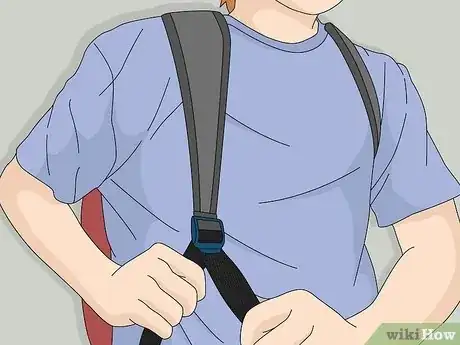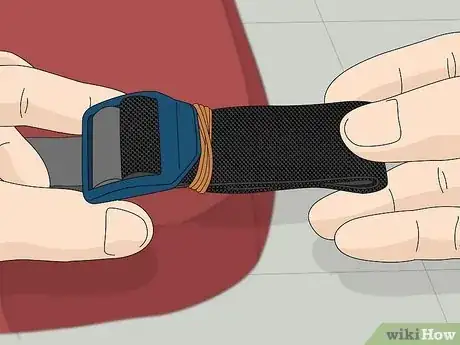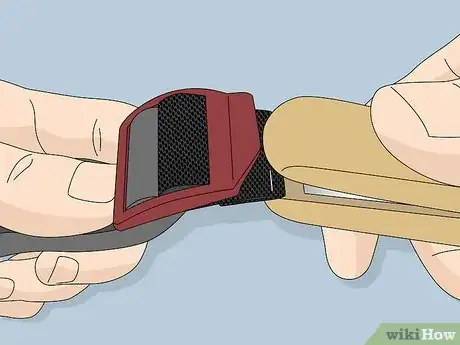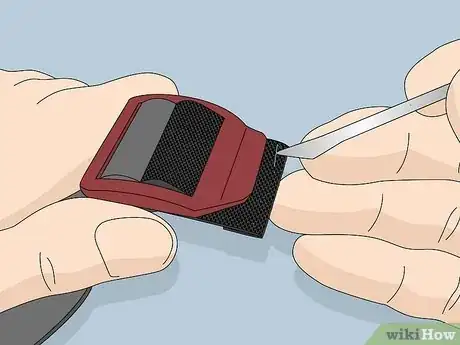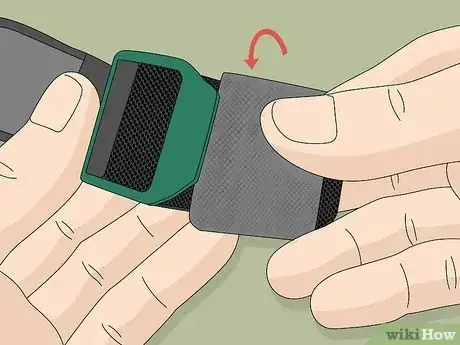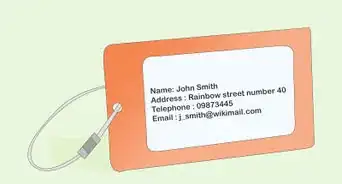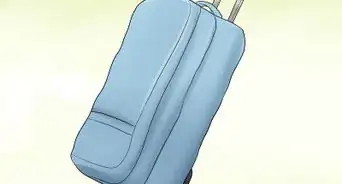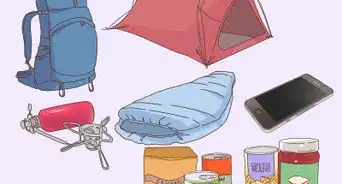This article was co-authored by wikiHow Staff. Our trained team of editors and researchers validate articles for accuracy and comprehensiveness. wikiHow's Content Management Team carefully monitors the work from our editorial staff to ensure that each article is backed by trusted research and meets our high quality standards.
This article has been viewed 140,216 times.
Learn more...
Backpacks have two straps to give leeway for the backpacker to adjust their style or comfort level. Over time, worn out straps may slip through the mechanism, and manage to throw the weight off one shoulder and onto the other. Some serious hikers may also consider shedding some pounds by cutting off the excess straps. Here are some ways to adjust, trim, or tuck your straps away for a different school, hiking, or traveling adventure.
Steps
Using the Shortening Mechanism on the Backpack
-
1Put the backpack on and adjust the straps. The cushion on the top of the strap should rest evenly and comfortably on top of your shoulders. The backpack should not sag below your behind. Instead, it should run parallel to your back when you are walking.[1]
- If you notice the backpack sagging below your behind, there may be too much weight in the backpack or you may need to get a backpack that has a reinforced bottom so it does not sag.
-
2Measure each side of the straps to ensure an equal distribution. You can measure each strap by taking off the backpack and holding each strap taunt next to each other. Make sure both straps are the same length as uneven straps may strain your body, especially your neck and shoulders. As well, even straps will ensure there is an equal distribution of weight when you wear your backpack.Advertisement
-
3Fold the remaining material. You may need to make one to two folds to tuck the straps under the tightening mechanism. You may also cut the remaining material if the straps are too long and you have no future use for them. Leave 2-4 inches for room to adjust.
- If you cut the material, melt the folded area with a lighter.[2]
-
4Tuck the material under the mechanism. Feel free to reinforce the fold with some twine or rubber bands to help the straps to stay in place. You can tie the twine around the fold and secure it with a knot or wrap rubber bands around the fold to secure it in place.
Trimming the Straps
-
1Adjust your bag straps to a comfortable length. The top of the straps should rest comfortably on your shoulders. You should put the backpack on and adjust the straps until the bag fits well, with no sagging below your behind.
-
2Cut the nylon straps. You will need to cut them so there is 1 inch (2.5 cm) of extra nylon sticking out past the plastic adjustment mechanism. Use fabric scissors or kitchen shears to get a clean cut on both straps.[3]
-
3Fold over the extra inch into a half-inch square. Then, staple over the fold about three times. Be careful, as this will leave no room for adjustment in the future! You may want to leave 3-4 inches of strap for future serious backpacking trips.
-
4Melt the folded area slowly with a cigarette lighter. Make sure to do this outside as it will result in some smelly fumes that may not be ideal indoors or in an enclosed space.[4] Hold the lighter under the straps and slowly move it back and forth over the straps several times.
- The frays of the strap will melt into a single, thicker layer, which is too big to fit through the plastic adjustment mechanism. This will keep the rest of the strap from pulling through the adjustment mechanism.
-
5Remove the staples after the nylon has cooled. Use a staple remover to avoid finger pricks or accidents. Make sure to throw out the staples afterwards.
Folding the Straps
-
1Put on the backpack and adjust the straps to a comfortable length. Make sure the backpack is flush to your back and is not sagging past your behind.
- If you notice there are other straps on your backpack that are unnecessarily long, you can use this method to fold the straps.
-
2Place velcro or fastening tape on one end of the strap. You will need 5-6 inches of fastening tape per strap to ensure it can wrap around the folded strap. Fastening tape is the best option for this method, but you can also use rubber bands, zip ties, or twine.
-
3Fold and secure the straps. Begin at the end of the straps and roll the straps so they lie flat and even in a bundle. Once the straps have been folded up, secure them with the fastening tape by wrapping the tape around the straps.
Community Q&A
-
QuestionHow do I adjust a drawstring backpack?
 Actual WritingCommunity AnswerYou can pull the cords on each side, one at a time, until you achieve the right lengths.
Actual WritingCommunity AnswerYou can pull the cords on each side, one at a time, until you achieve the right lengths.
Things You'll Need
- Scissors
- Stapler
- Lighter
- Rubber band, twine, or fastening tape
Warnings
- Don't staple and then melt the straps unless it is already threaded through the plastic adjustment mechanism. If you fail to do so, you will have two useless straps that just happen to be the perfect length.⧼thumbs_response⧽
- Be careful not to burn your fingers while melting the straps.⧼thumbs_response⧽
References
- ↑ http://sectionhiker.com/how-to-fit-a-backpack/
- ↑ https://www.caminodesantiago.me/community/threads/trimming-backpack-straps.27740/
- ↑ http://www.makeit-loveit.com/2015/04/how-to-cut-fabric-perfectly-straight-and-square-it-up.html
- ↑ https://www.caminodesantiago.me/community/threads/trimming-backpack-straps.27740/
About This Article
If your backpack straps are too long and get in your way, there are several ways to shorten them. Start by adjusting your straps so they fit you just right. Then, fold the ends of the straps over once or twice and tuck the straps under the tightening mechanism. Secure them with a rubber band or piece of twine so they won’t fall out. Another way to shorten your straps is to cut the remaining material off if you don't have any future use for them. Just make sure to leave 2 to 4 inches for any minor adjustments. When you cut the material, melt the edges with a lighter so they won’t fray or slip through the tightening mechanism. To learn how to use velcro to secure long straps, keep reading!
